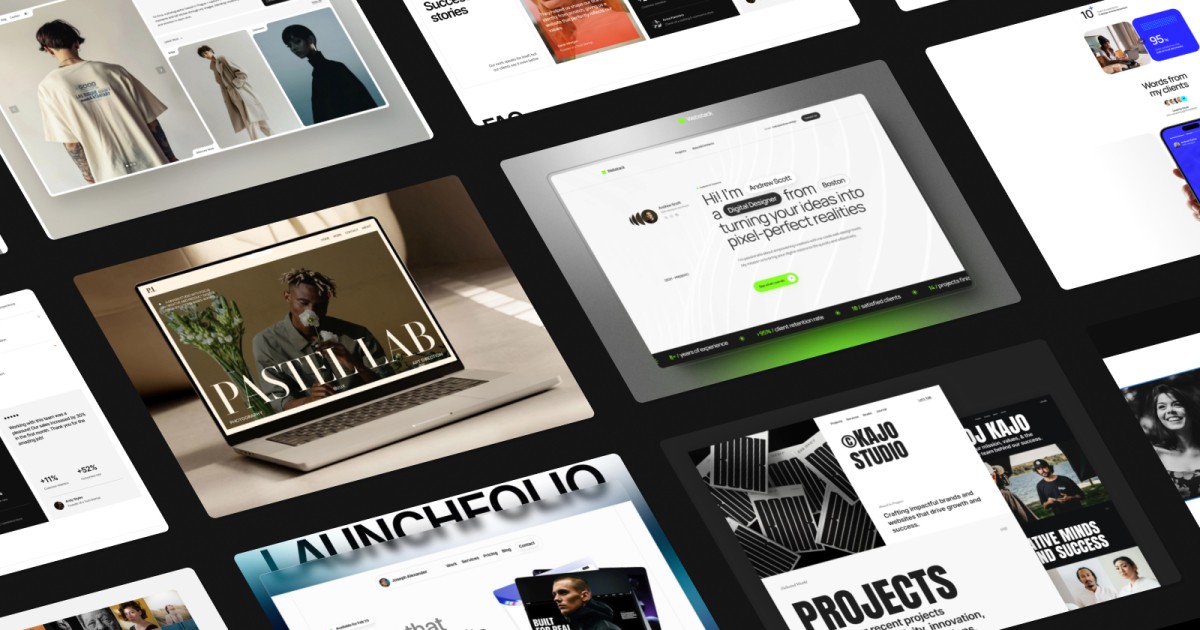Framer and Webflow are arguably two of the most popular tools in the space, but which is better for web agencies in 2025? In this article, we compare Framer and Webflow based on essential criteria – design flexibility, use ease, CMS & content, performance, integrations, pricing, and ideal uses – to help you find the right tool for your agency needs.
Fundamental differences in philosophy and approach
A fundamental difference between Framer and Webflow is their approach to layouts and canvas. Framer is strongly in the design-first freeform canvas, allowing you more freedom from strict flex-box or container structure.
Webflow, by contrast, is built on more of a structured layout approach, anchored in containers, boxes, flex, and grid, allowing for more predictability but boilerplate overhead.
In practice, designers moving from Figma - and those less comfortable with CSS syntax - might find Framer more intuitive from the start - while Webflow's somewhat constraint-based layouts can bring more stability and consistency as content grows, particularly with larger content sites.
Use Ease & Learning Curve
Framer is also touted for having a gentler learning curve to getting used to, particularly for designers who are less comfortable with CSS syntax.
Webflow offers a steeper ramp, with all its settings, class system, layout, etc.
With that said, once you learn Webflow, the depth of control gives users more fine-tuned control for the designs they want to create.
Feature Comparison: Considerations for Web Agencies
For web agencies, one of the fundamental differences is how well a platform can develop or maintain dynamic content (blogs, case studies, portfolios, etc.). Webflow is quite a bit more advanced in this regard - a range of CMS collections, support for relationships, paged and/or filtered content, and workflows that can get relatively complex tools.
Framer has improved its CMS, but Framer's model is relatively less flexible and less robust than Webflow, in general.
If your agency focuses heavily on sites with CMS or content, Webflow is a better scalable choice.
Performance, SEO & Quality of Code
Both platforms aim to develop clean-foldbing, performant code and adhere to the SEO best practices.
Webflow affords you precision control over things like meta tags, redirects, sitemaps, canonical URL sw, etc...
Framer automates much performance tuning in the background - optimizing to match Core Web Vitals or something similar - albeit, less granular than Webflow at times.
Overall, for clients needing SEO and content-focused agency level work, Webflow is better to customize and manage many SEO factors.
Integrations, E-commerce & 3rd Party Tools
Webflow has established a large ecosystem of integrations (Zapier, market platforms, keyboards, cms connectors, etc.) - and even has its own homegrown integrations for e-commerce.
Agencies looking for native e-commerce or full marketing stack workflow/full build out will look to Webflow.
Cost, Collaboration & Workflow Considerations
Framer is usually less expensive for at least entry and mid levels.
Webflow can scale its pricing as fast as you build out CMS items, collaborators, specialty For small agencies or side projects, Framer's price point can be convincing. But who's counting - at that scale it may not matter to much to you.
Team Collaboration & Versioning
Framer has real-time collaboration (multi-user rendering) and history, similar to Figma, which along with design will be nice if you are using design teams.
Webflow also has some collaboration features, but can essentially organize parts of the work (like content editing vs changes in design edits) within frameworks while working in the Webflow system via the designers or editors.
Agencies with overlapping content + design roles will not flinch if they are using Framer with - all the simultaneous collaboration functionality in one unified space.
Which Platform Is Better — Use Case Scenarios for Web Agencies
Let’s discuss what tool fits what agency type or what project type well.
When To Use Framer
A focus on interaction, motion, animations, storytelling, or micro-interactions.
Lean agency setups or small teams that want speed, simplicity, and design freedom over deep backend control.
Lighter content projects like landing pages, curated portfolios, or campaign microsites.
Teams that are used to design tools (like Figma, Sketch) and trying to have minimal friction in going into live site development.
If your agency wants a head start, you can also check out my Framer templates — they’re built specifically for speed, visual polish, and easy customization for client projects.

When To Use Webflow
Content-driven, CMS-heavy or large websites (blogs, multi-sectioned website, client portals).
E-commerce, complex integrations or custom data workflows.
Agencies needing control over detailed SEO elements, redirects, metadata, or to be able to export code.
Clients who are going to add or update content after the site goes live and need strong tools for doing so.
In many agencies, a hybrid approach comes into play: use Framer for an impactful, interactive piece or campaign site and then Webflow for a core content site.
FAQ
Can you switch from Framer to Webflow later (or the converse)
Yes, but it's not too easy. Most of your layout and component logic will need to be rebuilt, as well as interactions and content structure. All content (images, copy) can move over but assets and interactions can hardly be transferred.
Which has better SEO capabilities out of the box?
Webflow. Webflow offers far more built-in and advanced SEO functions (redirects, canonical tags, sitemaps, metadata) all in a cleaner class structure for fine-tuning. Framer auto handles a lot, but is less robust than Webflow in manual controls.
Can Framer do e-commerce sites?
Not natively. Framer does not have e-commerce features in the platform; you'll need to figure out and integrate third-party payment processor links or checkout tools for digital products. Webflow is a better option out of the box for e-commerce sites.




